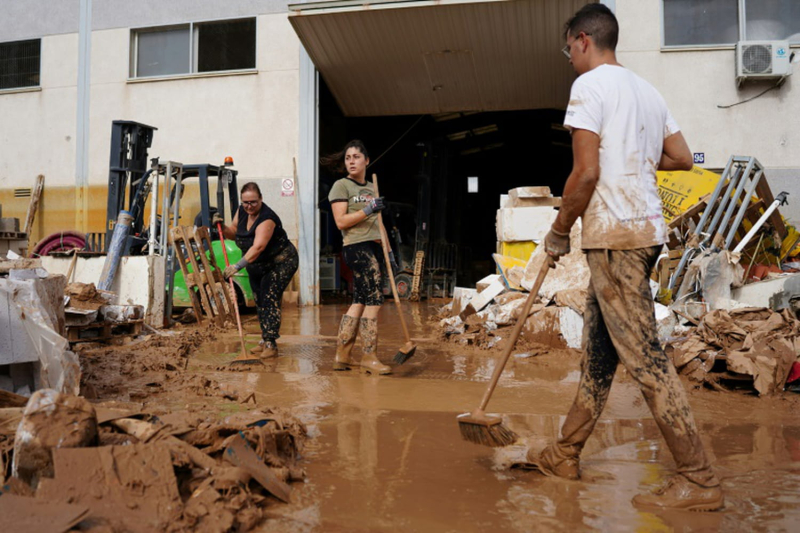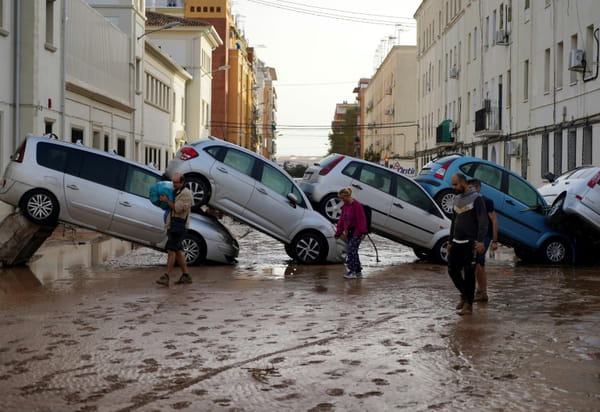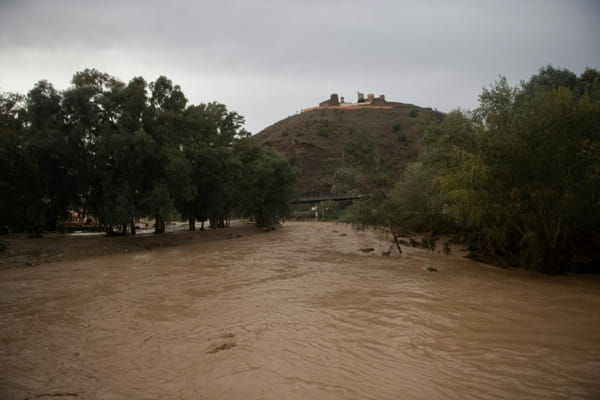The search for survivors continued frantically on Thursday in southeastern Spain, where residents, still traumatized by monstrous floods that killed around a hundred people, were urged to stay at home, as the risk remained high in some areas. In Paiporta, on the southern outskirts of Valencia, where around forty people are believed to have died, stunned residents tried to clean the streets, covered in viscous mud, in a veritable apocalyptic setting. “There is not a single business left standing,” David Romero, a 27-year-old musician, told an AFP journalist. On a visit to Valencia, the capital of the eponymous region that has recorded the highest number of victims (92 out of a total of 95), Prime Minister Pedro Sánchez strongly stressed that the bad weather episode was “not over” and called on the inhabitants of this region to “stay at home” and “not go out”. He was referring to a “red alert” (maximum alert level synonymous with extreme risk) launched on Thursday morning by the National Meteorological Agency (Aemet) for certain areas of the province of Castellón, located just north of that of Valencia, where heavy rains were expected. The regional government, which was sharply criticized for taking too long on Tuesday to warn the population of the risks caused by massive rainfall, this time sent a message without to delay. In Madrid, King Felipe VI also relayed the same message of caution, stating in a speech that the weather event that caused the flooding was “not yet over.” – “Many missing” – More than 1,200 soldiers are deployed on the ground, mainly in the Valencia region, alongside firefighters, police officers and rescue workers who are trying to locate possible survivors and are working to clear the disaster areas. M. Sánchez stressed that “the priority” was to find both “the victims and the missing”, without specifying the number. Residents walk through mud past cars piled up by floods in Sedavi, near Valencia, eastern Spain, on October 30, 2024 © AFP – Manaure QUINTERO The current death toll of 95, the highest since floods that killed 300 in October 1973, is set to rise because there are still “many missing,” warned Territorial Policy Minister Ángel Víctor Torres on Wednesday evening. Mr Sánchez's visit to Valencia, where he visited the Rescue Coordination Centre (Cecopi), coincided with the first of three days of national mourning declared by Spain's left-wing government. The Prime Minister was preceded in Valencia by the leader of the Popular Party (PP, right-wing opposition), Alberto Núñez Feijóo, who came to show his support for the president of the region, Carlos Mazón, a member of his party, who has been in the hot seat since Wednesday due to a possible delay in alerting residents. According to the authorities, thousands of people are still without electricity in the region. Many roads remain cut off, while countless car wrecks litter the roads, covered in mud and debris. – Nightmare Night – “I never thought I would experience this,” Eliu Sanchez, a resident of Sedavi, a town of 10,000 people on the outskirts of Valencia that was devastated by torrents of water and mud, told AFP, recounting a nightmare night. “We saw a young man in a vacant lot” taking refuge on the roof of his car,” said the 32-year-old electrician. “He tried to jump” onto another vehicle, but the current “carried him away,” he said. Overflowing of the Guadalhorce River in Alora, southern Spain, on October 29, 2024 © AFP – JORGE GUERRERO M. Mazón, the president of the Valencia region, also said that relief efforts had managed to reach all the affected areas, while several villages remained cut off from the rest of the country for much of Wednesday. High-speed trains between Madrid and Valencia, suspended since Wednesday, will remain so for at least “two to three weeks”, said the Minister of Transport, Óscar Puente. According to Aemet, more than 300 litres of water per square metre (30 cm) fell during the night from Tuesday to Wednesday in several towns in the Valencia region, with a peak of 491 litres (49.1 cm) in the small village of Chiva. This is the equivalent of “a year's worth of precipitation,” she said. The Valencia region and the Spanish Mediterranean coast in general regularly experience the so-called “gota fria” (cold drop) phenomenon in autumn, an isolated high-altitude depression that causes sudden and extremely heavy rain, sometimes lasting several days. Scientists say that extreme weather events, such as heat waves and storms, are both becoming more frequent and more intense due to climate change. All reproduction and representation rights reserved. © (2024) Agence France-Presse



